托福语法技巧:much,more,most
TOEFL语法笔记

TOEFL语法笔记王海波代词95%为错,情态动词永远不错,first 划线永远对,虚拟语气不考。
填空的基本做法:1 先找句子的分段点(即连词,分词,介词和标点符号)将句子分成记几段,选择要看的那部分句子,即只关注与空格相关的那部分句子。
句法:{①简单句: S+V②并列句:分句+并列句子+;句子+。
并列句划为简单句:句子,and/all/but+句子。
③复合句:主句+从句划为简单句2 简化句子简化原则:①adv/数/冠可以划掉②介词短语可以划掉③修饰名词的adj/n可以划掉④做状语的分词短语可以划掉⑤与空格无关的句子可以很划掉 p65-5/83 分析句子结构,判断空格中所缺的句子成分。
捷径:可直接套用句型和结构 p53-14 ,倒装句答案的首字母为系动词或助动词p92-14 * ——+n为There be 句型p210-74 区分四选项,结合句意和语感确定答案。
句子→简单句→主干→判断→选答案主语,——,谓宾。
100%考↓插入语定语从句或省略的定语从句定语从句中主和系可以同时省略which+be/that+be/who+be 可以省略①定语从句②n③adj短语/分词短语/介词改错做题要点:1 语法与句意并重,一定要通读全句(做题思想)。
2 一边读句意,一边思考划线部分的语法知识点是否正确。
3 熟悉掌握各种错误类型。
4 做题 ABCD要看全,选择一个最明显的错误,最好有明确的理由。
填空的固定句型和结构一主句专一结构 1-2※句子,句子。
为错任何句子只有一个主句,句子之间必须有连词。
※任何从句都是正常语序。
二谓语专一结构 3-4任何一个句子只有一个谓语,谓语动词之间一定要有连词连接。
※主谓……谓……错主谓……,谓……。
错三平行结构 5-6X and YX ,Y and Z 各元素必须一致 to do ,do and do 。
be done ,done and done。
※——,——,and——。
四 what 结构 7-8缩合连接代词(1)what =the thing that =all that thing 由句意定7 中what =the corp that 8 中what =the place that(2)what 在前后句中必须同时做成分 what =the thing that(3)n+what 错 n+the thing that √※prep+what+SVO 错 what →which√(4)what 引导的句子等于一个名词,可以做主语,宾语,表语。
比较级和最高级的用法:修饰量词
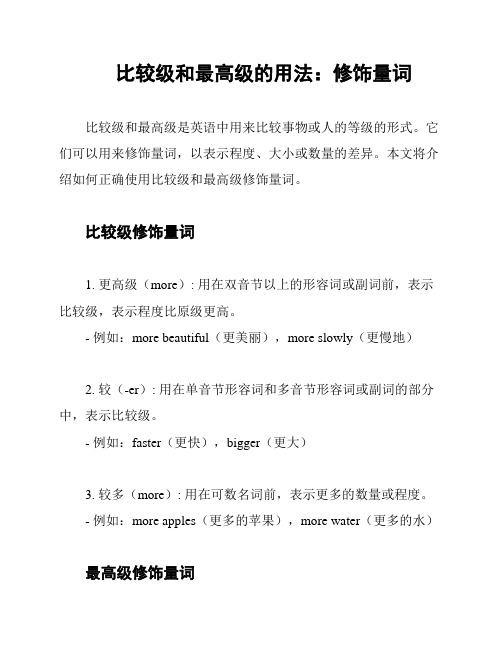
比较级和最高级的用法:修饰量词比较级和最高级是英语中用来比较事物或人的等级的形式。
它们可以用来修饰量词,以表示程度、大小或数量的差异。
本文将介绍如何正确使用比较级和最高级修饰量词。
比较级修饰量词1. 更高级(more): 用在双音节以上的形容词或副词前,表示比较级,表示程度比原级更高。
- 例如:more beautiful(更美丽),more slowly(更慢地)2. 较(-er): 用在单音节形容词和多音节形容词或副词的部分中,表示比较级。
- 例如:faster(更快),bigger(更大)3. 较多(more): 用在可数名词前,表示更多的数量或程度。
- 例如:more apples(更多的苹果),more water(更多的水)最高级修饰量词1. 最高级(the most): 用在双音节以上的形容词或副词前,表示最高级,表示程度最高。
- 例如:the most beautiful(最美丽),the most slowly(最慢地)2. 最(-est): 用在单音节形容词和多音节形容词或副词的部分中,表示最高级。
- 例如:fastest(最快),biggest(最大)3. 最多(the most): 用在可数名词前,表示最多的数量或程度。
- 例如:the most apples(最多的苹果),the most water(最多的水)注意事项:- 比较级和最高级通常用于比较两个或多个事物或人的差异。
- 对于双音节以上的形容词和副词,使用more和the most来表示比较级和最高级。
- 对于单音节形容词和副词,使用-er和-est来表示比较级和最高级。
- 对于可数名词,使用more和the most表示更多或最多的数量或程度。
希望本文对比较级和最高级修饰量词的正确使用有所帮助。
托福写作: 备考需掌握的35个句型
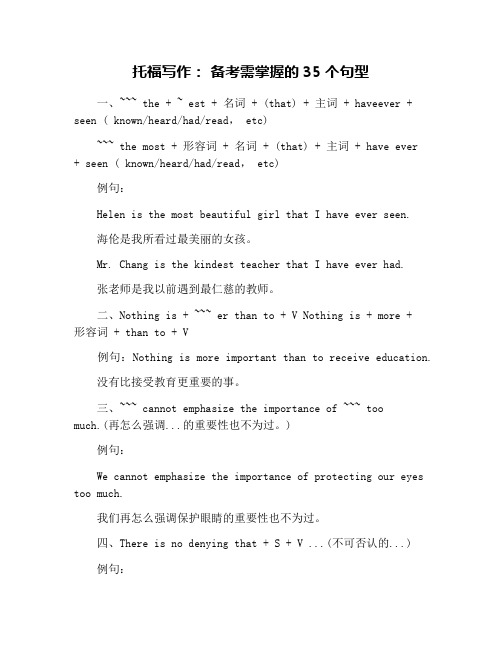
托福写作:备考需掌握的35个句型一、~~~ the + ~ est + 名词 + (that) + 主词 + haveever + seen ( known/heard/had/read, etc)~~~ the most + 形容词 + 名词 + (that) + 主词 + have ever + seen ( known/heard/had/read, etc)例句:Helen is the most beautiful girl that I have ever seen.海伦是我所看过最美丽的女孩。
Mr. Chang is the kindest teacher that I have ever had.张老师是我以前遇到最仁慈的教师。
二、Nothing is + ~~~ er than to + V Nothing is + more +形容词 + than to + V例句:Nothing is more important than to receive education.没有比接受教育更重要的事。
三、~~~ cannot emphasize the importance of ~~~ toomuch.(再怎么强调...的重要性也不为过。
)例句:We cannot emphasize the importance of protecting our eyes too much.我们再怎么强调保护眼睛的重要性也不为过。
四、There is no denying that + S + V ...(不可否认的...)例句:There is no denying that the qualities of our living have gone from bad to worse.不可否认的,我们的生活品质已经每况愈下。
五、It is universally acknowledged that + 句子~~ (全世界都知道...)例句:It is universally acknowledged that trees are indispensable to us.全世界都知道树木对我们是不可或缺的。
英语比较级和最高级的用法归纳

英语比较级和最高级的用法归纳在学习英语过程中,会遇到很多的语法问题,比如比较级和最高级的用法,对于这些语法你能够掌握吗?下面是小编整理的英语比较级和最高级的用法,欢迎阅读!英语比较级和最高级的用法一、形容词、副词的比较级和最高级的构成规则1.一般单音节词和少数以-er,-ow结尾的双音节词,比较级在后面加-er,最高级在后面加-est;(1)单音节词如:small→smaller→smallest short→shorter→shortesttall→taller→tallest great→greater→greatest(2)双音节词如:clever→cleverer→cleverest narrow→narrower→narrowest2.以不发音e结尾的单音节词,比较在原级后加-r,最高级在原级后加-st;如:large→larger→largest nice→nicer→nicest able→abler→ablest3.在重读闭音节(即:辅音+元音+辅音)中,先双写末尾的辅音字母,比较级加-er,最高级加-est;如:big→bigger→biggest hot→hotter→hottest fat→fatter→fattest4.以“辅音字母+y”结尾的双音节词,把y改为i,比较级加-er,最高级加-est;如:easy→easier→easiest heavy→heavier→heaviestbusy→busier→busiest happy→happier→happiest5.其他双音节词和多音节词,比较级在前面加more,最高级在前面加most;如:beautiful→more beautiful→most beautifuldifferent→more different→most differenteasily→more easily→most easily注意:(1)形容词最高级前通常必须用定冠词the,副词最高级前可不用。
备考托福阅读不用学语法

备考托福阅读不用学语法备考托福阅读不用学语法?来看看阅读中常见语法内容托福阅读常见语法点一主语谓语一致在英语句子里谓语受主语支配,其动词必须和主语在人称和数上保持一致,这就叫主谓一致。
寻其规律,大致可归纳为三个原则,即语法一致、逻辑意义一致和就近一致原则。
托福阅读常见语法点二比较级当比较两个事物时,用比较级,也就是-er形式或者用修饰词less和more。
当比较多于两个以上的事物时,用最高级,也就是-est形式或者做most和least 修饰。
托福阅读常见语法点三双重否定句在很多语言里.双重否定是正确的(如汉语)。
而在英语里,双重否定是错误的。
留意像“not none”,“hardly none”和“not never”这样的双重否定。
托福阅读常见语法点四阅读中常见的并列结构并列在一起的一系列的词或词组必须使用同样的形式。
例如,你不能说:“I was smiling,laughing and flirted.”而应该说:“I was smiling,laughing and flirting.”这种结构里的一系列的词或词组可以是名涧、动词、形容词或者副词。
托福阅读常见语法点五介词和介词短语记忆并学会识别像of这些常用介问。
某些介词总是能够和某些词共同构成词组。
例如,可以说:you have a percentage of something,而不能说:a percentage with something.介词引导介词短语,(像of the mountains或down the street)。
考生要会辨认介词短语,这样你可以在辨别主谓是否一致时不受介词短语的干扰。
介词后面经常跟着以ng结尾的词(这些词叫做动名词——gerunds),例如He won by running faster.从上文中我们可以看到,托福阅读中常见的语法点很多,所以学好语法对于托福阅读提升帮助非常大,希望大家在备考中能多多注意。
托福测试辅导:语法讲解(12)

托福测试辅导:语法讲解(12)第二节比较级英文中形容词在进行比较时需变为比较级,主要有两种形式:在词尾加-er (单音节形容词),如:fast-faster, large-larger, busy-busier, big-bigger等;或在词前加more (多音节形容词),如:more useful, more complex等少数词比较级形式特殊,如:good(well)-better, bad(ill)-worse, many(much)-more, little-less,far-farther(更远的)/further(更进一步的),考点一含有标志词than1.最常见的比较级句式是由连词than引导比较的对象,如:It takes less time to go there by air than by train.She possesses more books than I do.He is more intelligent than I expected.than可视为比较级的标志词,在填空题中,空后含有than的,通常空格处需要填比较级,空格前含有比较级的,通常空格处需要填than引导的从句。
例题:(1)Maine has ---- weather than most of the other states in the continental United States.(A) coolest(B) the coolest(C) cooler(D) the cooler答案:A解释:标志词than意味着应用比较级,A, B可先排除;D多the; 只有A正确(2)Pennsylvania has the most institutions of higher learning than any other state has.应改为:more解释:标志词than表明此句应用比较级,而不是级 2.为避免重复,than之后的从句中有些成分可以省略,只把相比的部分突出出来:情况1: 用指示代词that, those来代替省略的部分,如:The population of China is much larger than that of Great Britain.(that 指代the population)His designs won more acclaim than those of his fellow colleagues.(those 指代 designs)情况2: 在省略的过程中,若than之后从句的谓语部分相同, 比较的是主语部分, 那么谓语部分通常用助动词do来代替, 并且习惯上将从句主语和助动词倒装 (do + 主语)如:The actors usually capture greater attention than do the playwrights who mayprobably contribute more to the success of a play.例题:Mammals have a larger, more well-developed brain ---- other animals.(A) than do(B) that are having(C) which have(D) that do答案:A。
托福考试语法题
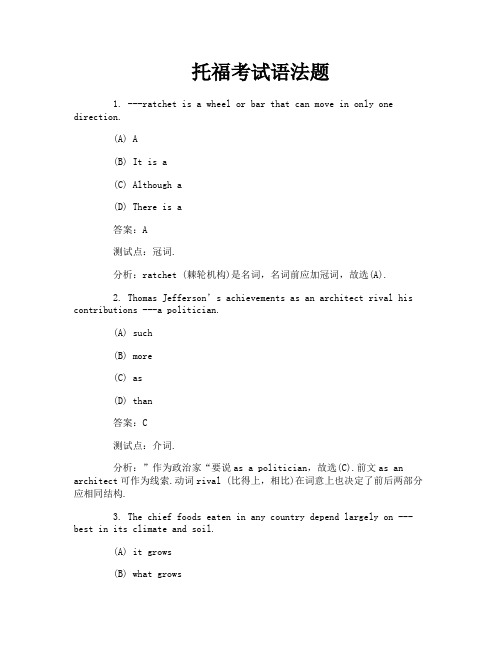
托福考试语法题1. ---ratchet is a wheel or bar that can move in only one direction.(A) A(B) It is a(C) Although a(D) There is a答案:A测试点:冠词.分析:ratchet (棘轮机构)是名词,名词前应加冠词,故选(A).2. Thomas Jefferson’s achievements as an architect rival his contributions ---a politician.(A) such(B) more(C) as(D) than答案:C测试点:介词.分析:”作为政治家“要说as a politician,故选(C).前文as an architect可作为线索.动词rival (比得上,相比)在词意上也决定了前后两部分应相同结构.3. The chief foods eaten in any country depend largely on ---best in its climate and soil.(A) it grows(B) what grows(C) does it grow(D) what does it grow答案:B测试点:what引导的名词从句。
分析:depend on后接名词性的成份。
答案中(B)是名词从句,做介词on 的宾语.(A)是主谓结构但并非名词从句,不能作宾语,(C)是问句形式,(D)结构错误.4. Possibly the greatest advance in ---materials came with the invention of a cheap way to make steel.(A) bridge-building(B) building of bridges(C) building a bridge(D) bridges are built答案:A测试点:定语.分析:materials是名词,前面要用形容词性的'词来修饰它.(A)是分词,可作定语.(B)是动名词短语;(C)是动宾结构;(D)是句子;均不可作定语.5. ---, snakes frequently subdue their prey without injecting poison.(A) Contrary to general belief(B) General belief contrary to(C) Belief contrary to general(D) Contrary belief general to答案:A测试点:习语.分析:contrary to+名词是.固定短语,表示“与……相反”,故选(A).6. Two years after she was chosen president of the Texas State Senate, ---successfully for a seat in the United States Congress.(A) Barbara Jordan’s campaign being(B) Barbara Jordan campaigned(C) Campaigning for Barbara Jordan(D) Barbara Jordan campaigning答案:B测试点:复合句。
比较级与最高级知识点总结

比较级与最高级知识点总结在英语语法中,比较级和最高级是非常重要的概念,它们帮助我们更准确、更生动地描述事物之间的程度差异。
接下来,让我们一起深入了解一下比较级和最高级的相关知识点。
一、比较级1、构成规则(1)一般在词尾直接加 er,例如:tall taller,short shorter。
(2)以不发音的 e 结尾的单词,直接加 r,比如:nice nicer,wide wider。
(3)重读闭音节词,双写末尾的辅音字母,再加 er,像:big bigger,hot hotter。
(4)以“辅音字母+y”结尾的词,把 y 变为 i,再加 er,例如:heavy heavier,busy busier。
(5)多音节词和部分双音节词,在词前加 more,比如:beautiful more beautiful,careful more careful。
2、用法(1)表示两者之间的比较,常用“比较级+than”的结构。
例如:He is taller than me (他比我高。
)(2)比较级前可以用much,a lot,far,even,a little 等词来修饰,表示程度上的差异。
例如:She is much more beautiful than her sister(她比她妹妹漂亮得多。
)(3)“the +比较级,the +比较级”,表示“越……,越……”。
比如:The more you read,the more you know (你读得越多,知道得就越多。
)二、最高级1、构成规则(1)一般在词尾直接加 est,例如:tall tallest,short shortest。
(2)以不发音的 e 结尾的单词,直接加 st,比如:nice nicest,wide widest。
(3)重读闭音节词,双写末尾的辅音字母,再加 est,像:big biggest,hot hottest。
(4)以“辅音字母+y”结尾的词,把 y 变为 i,再加 est,例如:heavy heaviest,busy busiest。
托福写作常用连接词12个
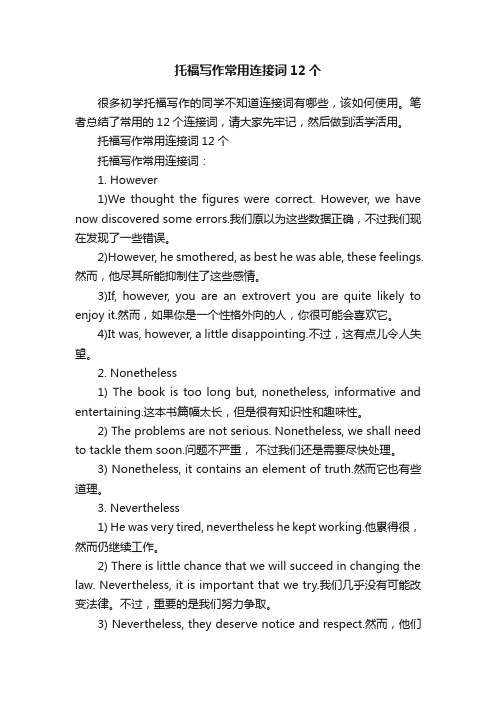
托福写作常用连接词12个很多初学托福写作的同学不知道连接词有哪些,该如何使用。
笔者总结了常用的12个连接词,请大家先牢记,然后做到活学活用。
托福写作常用连接词12个托福写作常用连接词:1. However1)We thought the figures were correct. However, we have now discovered some errors.我们原以为这些数据正确,不过我们现在发现了一些错误。
2)However, he smothered, as best he was able, these feelings.然而,他尽其所能抑制住了这些感情。
3)If, however, you are an extrovert you are quite likely to enjoy it.然而,如果你是一个性格外向的人,你很可能会喜欢它。
4)It was, however, a little disappointing.不过,这有点儿令人失望。
2. Nonetheless1) The book is too long but, nonetheless, informative and entertaining.这本书篇幅太长,但是很有知识性和趣味性。
2) The problems are not serious. Nonetheless, we shall need to tackle them soon.问题不严重,不过我们还是需要尽快处理。
3) Nonetheless, it contains an element of truth.然而它也有些道理。
3. Nevertheless1) He was very tired, nevertheless he kept working.他累得很,然而仍继续工作。
2) There is little chance that we will succeed in changing the law. Nevertheless, it is important that we try.我们几乎没有可能改变法律。
比较级的用法
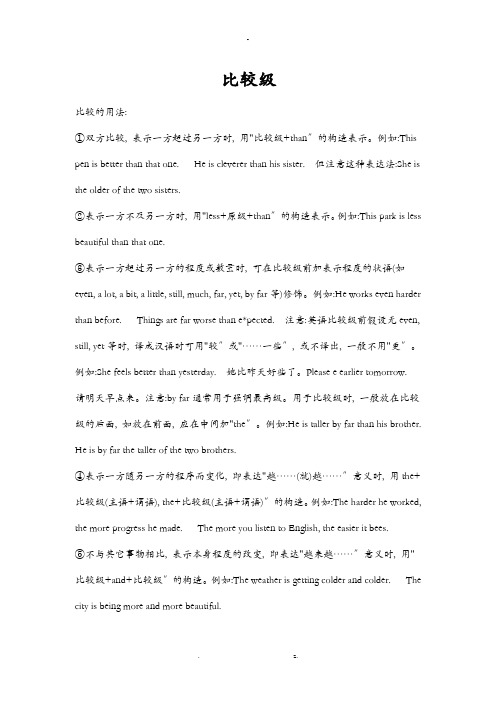
比较级比较的用法:①双方比较, 表示一方超过另一方时, 用"比较级+than〞的构造表示。
例如:This pen is better than that one. He is cleverer than his sister. 但注意这种表达法:She is the older of the two sisters.②表示一方不及另一方时, 用"less+原级+than〞的构造表示。
例如:This park is less beautiful than that one.③表示一方超过另一方的程度或数量时, 可在比较级前加表示程度的状语(如even, a lot, a bit, a little, still, much, far, yet, by far等)修饰。
例如:He works even harder than before. Things are far worse than e*pected. 注意:英语比较级前假设无even, still, yet等时, 译成汉语时可用"较〞或"……一些〞, 或不译出, 一般不用"更〞。
例如:She feels better than yesterday. 她比昨天好些了。
Please e earlier tomorrow.请明天早点来。
注意:by far通常用于强调最高级。
用于比较级时, 一般放在比较级的后面, 如放在前面, 应在中间加"the〞。
例如:He is taller by far than his brother. He is by far the taller of the two brothers.④表示一方随另一方的程序而变化, 即表达"越……(就)越……〞意义时, 用the+比较级(主语+谓语), the+比较级(主语+谓语)〞的构造。
例如:The harder he worked, the more progress he made. The more you listen to English, the easier it bees.⑤不与其它事物相比, 表示本身程度的改变, 即表达"越来越……〞意义时, 用"比较级+and+比较级〞的构造。
many much more most的用法和区别
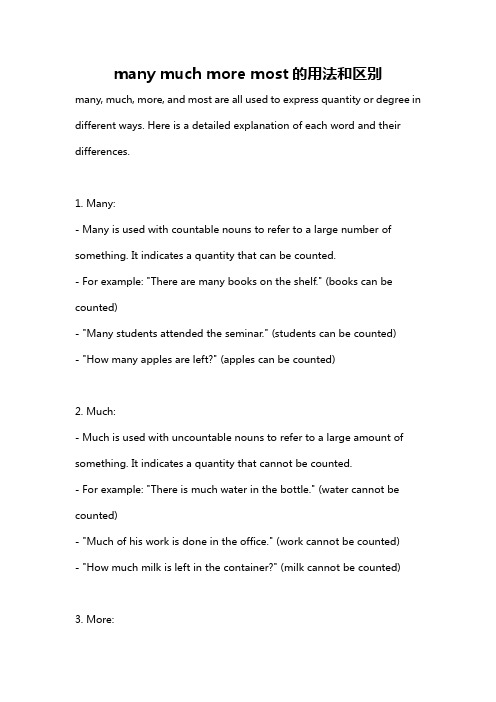
many much more most的用法和区别many, much, more, and most are all used to express quantity or degree in different ways. Here is a detailed explanation of each word and their differences.1. Many:- Many is used with countable nouns to refer to a large number of something. It indicates a quantity that can be counted.- For example: "There are many books on the shelf." (books can be counted)- "Many students attended the seminar." (students can be counted)- "How many apples are left?" (apples can be counted)2. Much:- Much is used with uncountable nouns to refer to a large amount of something. It indicates a quantity that cannot be counted.- For example: "There is much water in the bottle." (water cannot be counted)- "Much of his work is done in the office." (work cannot be counted)- "How much milk is left in the container?" (milk cannot be counted)3. More:- More is used to compare two quantities or degrees. It indicates an increase or addition to what already exists.- For example: "She wants more candy than her sister." (comparing quantities of candy)- "He earns more money than his coworkers." (comparing amounts of money)- "We need more time to finish the project." (referring to an additional amount of time)4. Most:- Most is used to refer to the highest degree or quantity of something. It indicates a large majority or the greatest extent.- For example: "Most people prefer chocolate over vanilla." (referring to the majority of people)- "He is the most talented athlete on the team." (referring to the highest degree of talent)- "She spends most of her time studying." (referring to the greatest extent of time)Now let's compare the differences between these words in more detail:1. Countable vs. Uncountable:- Many is used with countable nouns, while much is used with uncountable nouns.- Countable nouns are things that can be counted individually, such as books, students, or apples.- Uncountable nouns are things that cannot be counted individually, such as water, work, or milk.2. Quantity vs. Degree:- Many and much are used to indicate quantity or amount, while more and most are used to indicate a higher degree or additional quantity.- Many and much focus on the specific number or amount, while more and most focus on comparing or increasing what already exists.3. Comparative vs. Superlative:- More is used to compare two quantities or degrees, while most is used to refer to the greatest extent or highest degree.- More is used when comparing two things, while most is used when there are more than two things and one stands out as the highest or greatest.4. Context and Usage:- Many and much are more commonly used in affirmative statements,questions, and negative statements.- More and most are used in comparative statements, superlative statements, and to show an increase or addition.In conclusion, many, much, more, and most are used to express quantity or degree in different ways. Many is used with countable nouns, much is used with uncountable nouns, more is used to compare, and most is used to refer to the highest degree or majority. The choice of word depends on the noun being used, the context, and the intended meaning.。
托福考试辅导:语法讲解(15)

第三节级 考点⼀级的形式 ⼀、英⽂中表⽰最的概念时,形容词要变为级,其形式主要有两种: 在词尾加-est (单⾳节形容词), 如:low-lowest, late-latest, lucky-luckiest, fit-fittest; 或在词之前加most (多⾳节形容词), 如:most important, most sensitive 少数词级形式特殊,如:good(well)-best, bad(ill)-worst, many(much)-most, little-least, etc. TOEFL经常会出现这样的搭配: most highest, 这是不对的,hightest已经是级,前⾯当然不能在加most. 例题: (1) The most easiest process for mining gold is panning, which involves using a circular dish with a small pocket at the bottom. 应改为:easiest. 解释:easiest本⾝已是级, most纯属画蛇添⾜, 应去掉 ⼆、没有等级的形容词 有些形容词本⾝就具有“⽐….年长”、“ ⽐…..优越”等含义,因此也就没有⽐较级和级。
⽐如: inferior, superior, senior, anterior。
这些形容词往往和to连⽤,⽽不和than连⽤。
有些形容词本⾝就具备“最、极”的含义,所以就没有级和⽐较级。
如: absolute(绝对的), unique(独⼀⽆⼆的), infinite(⽆限的), round(圆的), right(对的), correct(正确的), wrong(错误的), perfect(完美的),这类形容词往往被称为绝对形容词 例题: Geoffrey Chaucer occupies a ---- place in English literature. (A) most unique (B) unique (C) least unique (D)very unique 答案: B。
托福写作中不可忽视的5个语法点

托福写作中不可忽视的5个语法点很多托友似乎渐渐忽视了语法的重要性,认为那是中学时代才应该重点学习的内容。
下面就和大家分享托福写作中不可忽视的5个语法点,希望能够帮助到大家,来欣赏一下吧。
托福写作中不可忽视的5个语法点1.“amounts of”和“numbers of”的用法一样吗?有同学会在作文里写“amounts of people have the opportunity to work at home nowadays”这样的句子。
也有很多同学写过“a great amount of historical buildings”或“the amount of printed books”这样的表达。
他们往往将“amounts of”或“an amount of”当成了“a lot of”或“lots of”的替代表达。
“a lot of”或“lots of”一般来说的确不太适合用在书面表达中,但是它们修饰的名词可以是可数名词,也可以是不可数名词,因此用不着多做考虑。
然而,用“an amount of”或“amounts of”来修饰的名词,根据标准用法的要求,应该修饰物质名词(如water)或抽象名词(如pain),也就是不可数的名词。
因此,用它们来修饰“people”、“buildings”这样的可数名词是不正确的。
那么,什么量词用来修饰可数名词呢?“a number of”或“numbers of”,如:“a large number of cars”。
语法要点:“an amount of”或“amounts of”用在不可数名词前面,而“a number of”或“numbers of”用在可数名词前面。
其区别基本相当于“many”和“much”的区别。
2.“between”后面能接两个以上的事物或人物吗?“between”和“among”有什么区别也是大家常问的一个问题。
有这样的说法:“between”表示“两者之间”,后面应该接两个事物或人物;“among”表示“多者之间”,后面接三个及其以上的事物或人物。
托福 语法
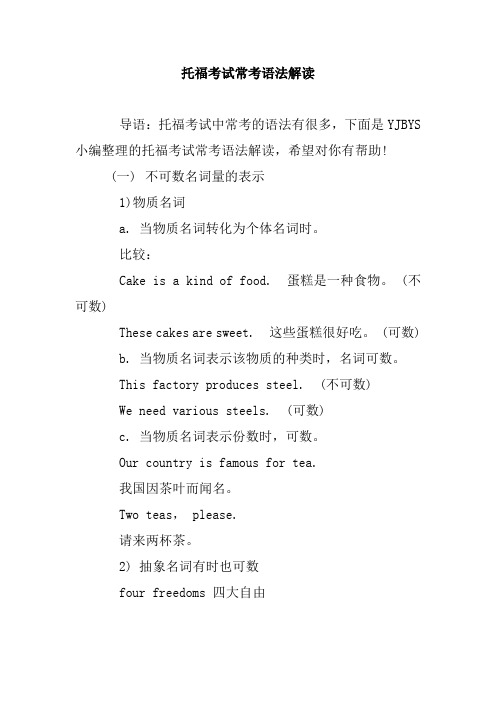
托福考试常考语法解读导语:托福考试中常考的语法有很多,下面是YJBYS 小编整理的托福考试常考语法解读,希望对你有帮助!(一)不可数名词量的表示1)物质名词a. 当物质名词转化为个体名词时。
比较:Cake is a kind of food. 蛋糕是一种食物。
(不可数)These cakes are sweet. 这些蛋糕很好吃。
(可数)b. 当物质名词表示该物质的种类时,名词可数。
This factory produces steel. (不可数)We need various steels. (可数)c. 当物质名词表示份数时,可数。
Our country is famous for tea.我国因茶叶而闻名。
Two teas, please.请来两杯茶。
2) 抽象名词有时也可数four freedoms 四大自由the four modernizations四个现代化物质名词和抽象名词可以借助单位词表一定的数量。
如:a glass of water 一杯水a piece of advice 一条建议(二)重点语法概念1)形容词2)副词3)比较4)措辞错误5)双重否定6)不完整句子7)并列结构8)介词和介词短语9)代词指代10)主谓一致形容词形容词修饰名词或代词,说明事物或人的性质或特征。
通常,可将形容词分成性质形容词和叙述形容词两类,其位置不一定都放在名词前面。
形容词是修饰回答像what kind of或which?或whose?这类的问题。
不要混淆形容词和副词,副词通常是以ly结尾的,而极少形容词以ly结尾。
1)以ly结尾的形容词:friendly,deadly,lovely,lonely,likely,lively,ugly,brotherly.2)以-ly 结尾既为形容词,也为副词:daily,weekly,monthly,yearly,early.副词副词通常修饰动词,形容词,副词或其他结构。
托福考试语法攻略
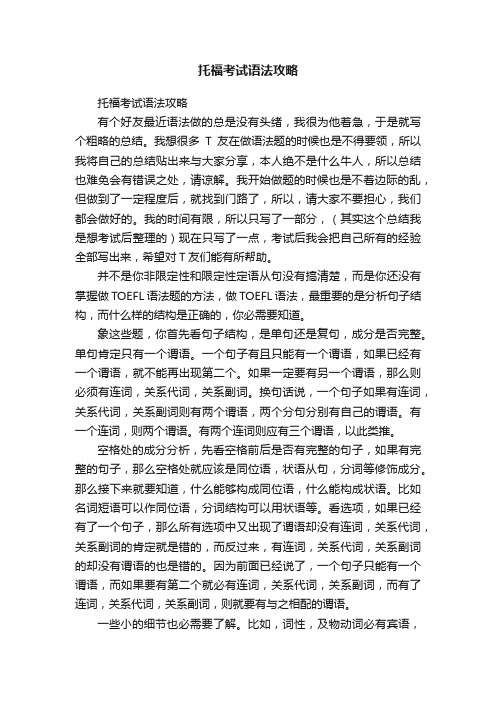
托福考试语法攻略托福考试语法攻略有个好友最近语法做的总是没有头绪,我很为他着急,于是就写个粗略的总结。
我想很多T友在做语法题的时候也是不得要领,所以我将自己的总结贴出来与大家分享,本人绝不是什么牛人,所以总结也难免会有错误之处,请谅解。
我开始做题的时候也是不着边际的乱,但做到了一定程度后,就找到门路了,所以,请大家不要担心,我们都会做好的。
我的时间有限,所以只写了一部分,(其实这个总结我是想考试后整理的)现在只写了一点,考试后我会把自己所有的经验全部写出来,希望对T友们能有所帮助。
并不是你非限定性和限定性定语从句没有搞清楚,而是你还没有掌握做TOEFL语法题的方法,做TOEFL语法,最重要的是分析句子结构,而什么样的结构是正确的,你必需要知道。
象这些题,你首先看句子结构,是单句还是复句,成分是否完整。
单句肯定只有一个谓语。
一个句子有且只能有一个谓语,如果已经有一个谓语,就不能再出现第二个。
如果一定要有另一个谓语,那么则必须有连词,关系代词,关系副词。
换句话说,一个句子如果有连词,关系代词,关系副词则有两个谓语,两个分句分别有自己的谓语。
有一个连词,则两个谓语。
有两个连词则应有三个谓语,以此类推。
空格处的成分分析,先看空格前后是否有完整的句子,如果有完整的句子,那么空格处就应该是同位语,状语从句,分词等修饰成分。
那么接下来就要知道,什么能够构成同位语,什么能构成状语。
比如名词短语可以作同位语,分词结构可以用状语等。
看选项,如果已经有了一个句子,那么所有选项中又出现了谓语却没有连词,关系代词,关系副词的肯定就是错的,而反过来,有连词,关系代词,关系副词的却没有谓语的也是错的。
因为前面已经说了,一个句子只能有一个谓语,而如果要有第二个就必有连词,关系代词,关系副词,而有了连词,关系代词,关系副词,则就要有与之相配的谓语。
一些小的细节也必需要了解。
比如,词性,及物动词必有宾语,如果没有宾语,肯定是以过去分词形式存在,如果过去分词做谓语,则其前面必有be动词。
常用比较级最高级归纳
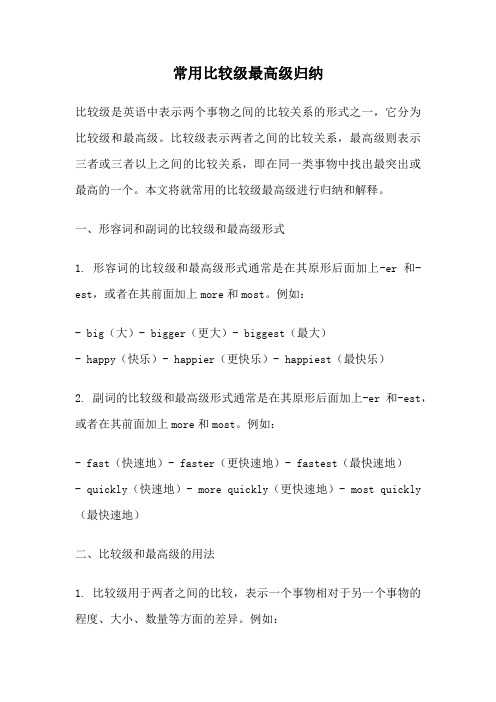
常用比较级最高级归纳比较级是英语中表示两个事物之间的比较关系的形式之一,它分为比较级和最高级。
比较级表示两者之间的比较关系,最高级则表示三者或三者以上之间的比较关系,即在同一类事物中找出最突出或最高的一个。
本文将就常用的比较级最高级进行归纳和解释。
一、形容词和副词的比较级和最高级形式1. 形容词的比较级和最高级形式通常是在其原形后面加上-er和-est,或者在其前面加上more和most。
例如:- big(大)- bigger(更大)- biggest(最大)- happy(快乐)- happier(更快乐)- happiest(最快乐)2. 副词的比较级和最高级形式通常是在其原形后面加上-er和-est,或者在其前面加上more和most。
例如:- fast(快速地)- faster(更快速地)- fastest(最快速地)- quickly(快速地)- more quickly(更快速地)- most quickly (最快速地)二、比较级和最高级的用法1. 比较级用于两者之间的比较,表示一个事物相对于另一个事物的程度、大小、数量等方面的差异。
例如:- The weather is colder today than yesterday.(今天的天气比昨天冷。
)- He is taller than his brother.(他比他的哥哥高。
)2. 最高级用于三者或三者以上的比较,表示在同一类事物中找出最突出或最高的一个。
例如:- This is the tallest building in the city.(这是城里最高的建筑。
)- She is the most beautiful girl in our class.(她是我们班最漂亮的女孩。
)三、比较级和最高级的特殊形式1. 比较级和最高级的特殊形式可以通过在形容词或副词前面加上more和most来表示。
例如:- more expensive(更贵的)- most difficult(最困难的)2. 有些形容词和副词的比较级和最高级形式是不规则的,需要进行记忆。
托福测试辅导:语法讲解(17)

托福测试辅导:语法讲解(17)
考点四 most的其他用法
对于most来讲,除了构成某些词级外,most的用法有几点需要注意,经常成为改错题的考点:
1.当most表示大多数时,之前不加the, 并且有两种形式来表示大多数,分别为:
most + 名词,如:most people, most Indian tribes;
most + of + 限定词 + 名词或代词,如:most of his paintings,most of us, most of the modern artists
2. most有时意思等同于very, 此时most之前用不定冠词,如:
a most lovely girl, a most impressive proposal
例题:
(1)
The most substances expand in volume when they are heated.
应改为:Most
解释:most只有在表示形容词级作定语时需加定冠词,此句表示“大多数”,没必要加the.
(2)
The most often flour is made from wheat, but it may also be made from the seeds of other cereal plants.
应改为:most.
解释:the most 一般出现在级中, 此句most often为固定说法,意为经常
词汇:cereal: 谷类的。
比较级more和much的用法区别

比较级more和much的用法区别much是用来修饰比较级的,much more beautiful;more是用来构成比较级的,more beautiful;more是much、many的比较级,most是much、many的最高级,而much是修饰不可数名词,many 是修饰不可数名词。
much、many意为“很多”是原级,且much+不可数名词、many+可数名词。
more意为“更多”是比较级+多音节形容词、副词或+名词、most因为“最多”是最高级+多音节形容词、副词或+名词。
more例句与用法1.His illness was more serious than the doctor first thought.他的病较医生原来以为的更严重.2.There are more cars on the road in the summer than in the winter.夏天路上的车子比冬天多.3.She spends more and more time alone in her room.她独自呆在房间里的时间越来越多了.4.I am becoming more and more irritated by his selfish behaviour.我对他那种自私的行为愈加恼火起来.5.He couldn't lift the table and no more could I.他抬不动那张桌子,我也抬不动6.He speaks more and more openly about his problem.他越来越公开地谈他的问题,7.It took more or less a whole day to paint the ceiling.粉刷天花板用了将近一整天的时间.much:[ mʌtʃ ]a.许多的ad.很,非常pron.&n.许多[形容词比较级more;最高级most][副词比较级more;最高级most]例句与用法1.I think we may learn much from it.我想我们能从中学到许多。
比较级和最高级用法知识点总结
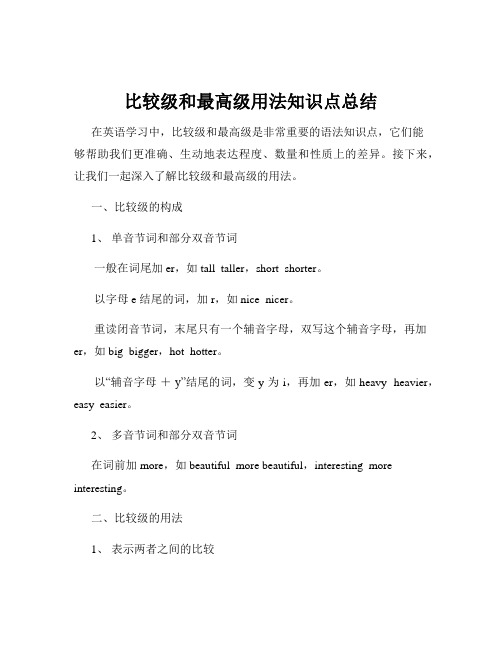
比较级和最高级用法知识点总结在英语学习中,比较级和最高级是非常重要的语法知识点,它们能够帮助我们更准确、生动地表达程度、数量和性质上的差异。
接下来,让我们一起深入了解比较级和最高级的用法。
一、比较级的构成1、单音节词和部分双音节词一般在词尾加 er,如 tall taller,short shorter。
以字母 e 结尾的词,加 r,如 nice nicer。
重读闭音节词,末尾只有一个辅音字母,双写这个辅音字母,再加er,如 big bigger,hot hotter。
以“辅音字母+y”结尾的词,变 y 为 i,再加 er,如 heavy heavier,easy easier。
2、多音节词和部分双音节词在词前加 more,如 beautiful more beautiful,interesting more interesting。
二、比较级的用法1、表示两者之间的比较A + be 动词+比较级+ than + B,如 He is taller than me (他比我高。
)A +实义动词+副词比较级+ than + B,如 She runs faster than him (她跑得比他快。
)2、比较级+ and +比较级,表示“越来越……”如 It's getting colder and colder (天气变得越来越冷。
)3、 The +比较级……,the +比较级……,表示“越……,越……”例如 The more you read, the more you know (你读得越多,知道得就越多。
)4、可以用 much、a little、a lot、even、far 等修饰比较级,加强程度例如 He is much taller than me (他比我高得多。
) She is a little fatter than before (她比以前胖了一点。
)三、最高级的构成1、单音节词和部分双音节词一般在词尾加 est,如 tall tallest,short shortest。
- 1、下载文档前请自行甄别文档内容的完整性,平台不提供额外的编辑、内容补充、找答案等附加服务。
- 2、"仅部分预览"的文档,不可在线预览部分如存在完整性等问题,可反馈申请退款(可完整预览的文档不适用该条件!)。
- 3、如文档侵犯您的权益,请联系客服反馈,我们会尽快为您处理(人工客服工作时间:9:00-18:30)。
托福语法技巧:much,more,most
more和most的用法相当自由:
You should ride more.
你必须多骑马。
I use this room most.
这个房间我用得最多。
但当much是原级时,使用范围较小。
much意为a lot(许多)时可修饰表示否定意思的动词:
He doesn’t ride much nowadays.
现在他不太骑马了。
在表示疑问的句子里much 主要与how连用。
在没有how的疑问句中可用much,但a lot 更常见:
How much has he ridden?
他骑马多吗?Has he ridden a lot/much?
他近来常骑马吗?在肯定句中as/so/too+much是可以的。
在没有as/so/too的情况下,肯定句中用a lot/a good deal/a great deal会更好:
He shouts so much that…
他叫喊的太厉害了,以至于……
I talk too much.
我说得太多了。
但是说:
He rides a lot/a great deal.
他常骑马。
very much意为greatly(非常)时,在肯定句中使用比较广泛。
常和它一起用的词有blame(责备),praise(赞扬),thank(感谢)及一些表达感情的动词:admire(钦佩),amuse (使娱悦),approve(赞成),dislike(不喜欢),distress (使烦恼),enjoy(喜爱),impress(使有深刻印象),like (喜欢),object(反对),shock(震惊),surprise(使惊奇)等等:
Thank you very much.
非常感谢你。
They admired him very much.
他们很钦佩他。
She objects very much to the noise they make.她非常反对他们弄出的噪音。
much(=greatly非常)可以和very连用,也可以省去very而与下列分词连用:admired(受钦佩的),amused (娱悦的),dis-liked(不受喜欢的),distressed(烦恼
的), impressed(留有……印象的),liked(受喜欢的),shocked(被震惊的),struck(受巨大影响的),upset(心烦意乱的)。
He was(very) much admired.
他很受人钦佩。
She was (very) much impressed by their good manners.
他们彬彬有礼,给她留下了深深的影响。
much意为a lot(许多)时能够修饰形容词的比较级和级及动词:
much better好多了much the best最
much more quickly快多了
much too可与形容词的原级连用:
He spoke much too fast.
他说话说得太快了。
most放在形容词或副词之前,有“很”的意思。
主要与双音节或多音节形容词/副词连用:
He was most apologetic.
他已表示十分的歉意了。
She behaved most generously.
她的行为非常慷慨大度。
